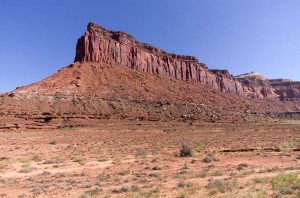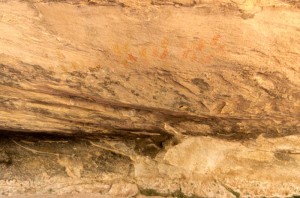We didn’t plan to get away too quickly this morning, as we didn’t have far to go. However, it took us far longer than we anticipated, as one of the leveling jacks on the trailer would not raise properly. After trying to fix it for about an hour, I finally gave up, tied it up with some wire so that it couldn’t hit the ground, and then we left.
We stopped in Moab at a car parts place to get some iron wire. The first store had none, but the smaller one right beside it did, so I bought a roll (far more than I need, but the smallest amount they would sell me). I hope that I can fix the broken part, a “nut” that is supposed to hold the jack screw on the way up, but which is slipping.
We then drove towards the south part of Canyonlands National Park, the Needles area. Along the way we passed Newspaper Rock, which is a stone wall with hundreds of petroglyphs scratched into the black rock varnish on the red sandstone. There were a lot of very nice buttes along the way as we drove into the park.
We stopped at Needles Outpost, a primitive commercial campground just outside the park. It is a very nice site, and we chose a spot right up against a high rock wall which rises sheer out of the sandy soil behind us. There are very large junipers here that some of the tenters are using for shade, and which separate the sites to give some privacy. The site is off the power grid, and they have a large bank of solar cells, as well as a backup generator for power.
After we were set up we drove into the park, stopped at the visitor center to get advice on how to spend our time here, which we followed and did three short hikes. The first two made use of the geological feature of the area which is overhanging rocks, that provide a natural “roof”. The first site, “Roadside Ruins” was an approximately 800 year old grain storage bin made of adobe and stones. The second, “Cave Spring” is a large area several hundred metres long where the overhanging rocks were used as shelter, originally by the native Americans, but more recently by cowboys. The rock roof was smoked and covered with soot. A very small seepage of water allowed some green plants to grow in the cracks of the rocks, and a small amount of water had accumulated in a tiny pool.
In the oldest part of the Cave Spring site there were many pictographs. There were hand prints in yellow and red on one spot on the roof. In another area there were hand outlines that seemed to be made from soot, as the interior was the color of the rock, and the outline was in black.
Finally we drove to the Potholes area, and walked around. While the potholes were all dry, there were more very interesting rock formations. The rocks here remind me of many of the sites we stopped at in the desert of Australia. The hand prints in particular are the only ones we’ve seen outside of those we first saw in Australia.


